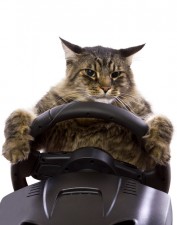 Cat in the driver's seat via Shutterstock
Cat in the driver's seat via Shutterstock
Cats are anathema for some folks — the sight of one gives them the heebie-jeebies, and there's even a medical term for fear of cats — ailurophobia. So they're probably quite willing to believe that, for example, a black cat crossing one's path is a harbinger of bad luck. Recently the news has been replete with warnings that cats (or a parasite they can harbor) are responsible for road rage!
The genesis of this anti-feline calumny is a study published in the Journal of Clinical Psychiatry that links infection with a cat-hosted parasite, Toxoplasma gondii with increased risk of agressive behavior. The authors of the study associated self-directed aggression, such as suicidal behavior, with positive tests for T. gondii infection. Somehow this got translated into aggression against others, e.g. road rage.
But a new story in the Washington Post counters this latest attack on our feline friends. Although it's true that the parasite only multiplies in cat intestines and it can be transmitted via unsanitary handling of litter boxes, it can also be transmitted from undercooked meat and contaminated water. And certainly it's a risk to pregnant women, since it can damage or kill their fetuses.
However, the author cited yet another study, which found " little evidence that T. gondii was related to increased risk of psychiatric disorder, poor impulse control, personality aberrations or neurocognitive impairment."
Anyway, links are not causation, as we've pointed out many times in the past. So even if a study finds an association between T. gondii infection and abberrant behavior, that doesn't mean the infection caused that behavior. It could well be that people who exhibit road rage or other aggressive behaviors ate more raw meat (think carpaccio, for example) or exhibited the behavior before being infected or associating with cats.
The bottom line — cats are not the culprits — ailurophobes need to look elsewhere to explain their aversion to the critters.



